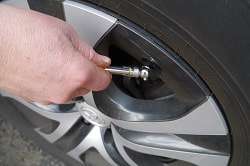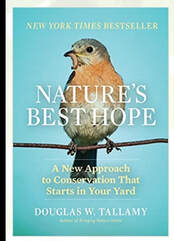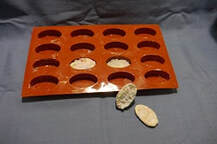
Source: Larry West, https://www.treehugger.com/keep-tires-inflated-save-the-planet-1203959
Photos by Sean O'Donnell
 According to Treehugger.com, improperly inflated tires can add approximately 1.5 tons of greenhouse gasses to the atmosphere per 12,000 miles driven. This occurs because underinflated tires require more energy to move, increasing the vehicle’s gas mileage. To avoid these additional emissions and save yourself some money from the cost of additional fuel, check your car’s tire pressure monthly and maintain it at the PSI recommended by the manufacturer. To get the most accurate reading, check the pressure before driving when the tires are cold. Source: Larry West, https://www.treehugger.com/keep-tires-inflated-save-the-planet-1203959 Photos by Sean O'Donnell  Nature’s Best Hope: A New Approach to Conservation that Starts in Your Back Yard Swarthmore Public Library, Swarthmore Horticultural Society, & the Swarthmore Environmental Advisory Council present a Q&A with Doug Tallamy about his book Thursday, March 31st at 7pm on Zoom Registration required. In Nature’s Best Hope, Douglas Tallamy uses his expertise as a Professor of Entomology and Wildlife Ecology at the University of Delaware to teach us about ecosystems and how to protect them. Specifically, he celebrates the power of private landowners and the choices we can make in our own backyards. Tallamy shares practical advice about how to transform your yard, along with information about the best plants to use and those to avoid. Nature’s Best Hope lays out all you need to know to participate in one of the greatest conservation projects of all time! In addition to reading the book, you can view three of Tallamy’s online talks, in advance of the Q&A: Nature’s Best Hope Making Insects: A Guide to Restoring the Little Things That Run the World The Nature of Oaks  Frustrated with those tiny ends of soap that seem like they could be useful but are too small to produce much lather? Save them up and reconstitute them into new bars. It takes only a few minutes to set them up. Give them a few days to dry, and you have new soap!
Adapted from: http://www.instructables.com/id/Reuse-Your-Old-Soap/ Photos by Susan O'Donnell Treehugger.com recommends electric leaf mulchers to help you use the leaves to enrich the soil in your yard. Author Stacy Tornio points out that "leaves are some of the most underutilized resources in the backyard. You can use them as organic mulch, compost, and cover for your plants and garden beds, saving you a lot of time and money over time. Having a good leaf mulcher is the key to making this possible.
When you have fallen leaves in the garden, one way to take care of them is by bagging them up and putting them out as yard waste. A more eco-friendly way to take care of them is to put them back into your own yard and garden. Yet, this can take up a lot of space and be slow to break down in your flower beds. By shredding and mulching the leaves instead, you can save a lot of space. Plus, it’ll make it easier for the material to break down in the garden soil or your compost bin."* She distinguishes them from leaf blowers in that "leaf mulchers will have a functionality much like a vacuum that sucks up the leaves into a compartment while shredding them at the same time." Stacy Tornio, May 17, 2022, "The 7 Best Leaf Mulchers of 2022," www.treehugger.com |
Categories
All
Archives
July 2024
|
|
|
